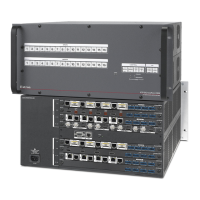Establishing a Connection
Establish a network connection to an XTP II CrossPoint switcher as follows:
1. Open a TCP socket to port 23 using the IP address of the switcher.
NOTE: If the local system administrators have not changed the value, the factory-
specified default, 192.168.254.254, is the correct value for this field.
The switcher responds with a copyright message including the date, the name of the
product, firmware version, part number, and the current date and time.
NOTES:
• If the switcher is not password-protected, the device is ready to accept SIS
commands immediately after it sends the copyright message.
• If the switcher is password-protected, a password prompt appears below the
copyright message.
2. If the switcher is password-protected, enter the appropriate administrator or user
password.
If the password is accepted, the switcher responds with Login User or Login
Administrator
.
If the password is not accepted, the Password prompt reappears.
Connection Timeouts
The Ethernet link times out after a designated period of time of no communications. By
default, this timeout value is set to five minutes but the value can be changed (see the
Configure port timeout SIS commands on page 118).
NOTE: Extron recommends leaving the default timeout at 5 minutes and periodically
issuing the Query (Q) command to keep the connection active. If there are long idle
periods, Extron recommends disconnecting the socket and reopening the connection
when another command must be sent.
Number of Connections
An XTP II CrossPoint switcher can have up to 200 simultaneous TCP connections, including
all http sockets and telnet connections. When the connection limit is reached, the switcher
accepts no new connections until some have been closed. No error message or indication
is given that the connection limit has been reached. To maximize performance of an IP Link
device, the number of connections should stay low and unnecessary open sockets should
be closed.
Using Verbose Mode
Telnet connections to an XTP II CrossPoint switcher can be used to monitor for changes
that occur on the switcher, such as front panel operations and SIS commands from other
telnet sockets or a serial port. For a telnet session to receive change notices from the
switcher, the telnet session must be in verbose mode 1 or 3 (see the Verbose Mode
definitions on page 116). In verbose mode 1 and 3, the telnet socket reports changes in
messages that resemble SIS command responses.
XTP II CrossPoint 1600, 3200, and 6400 Switchers • Programming Guide 78

